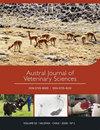野生巴塔哥尼亚水獭(Lontra provocax)和北美水貂(Neovison vison)的化学固定化
IF 0.5
4区 农林科学
Q3 VETERINARY SCIENCES
引用次数: 0
摘要
巴塔哥尼亚水獭(Lontra provocax)是智利南部和阿根廷特有的濒危物种。它的大部分分布范围最近已被美国水貂(Neovison vison)所占据。作为巴塔哥尼亚水貂影响长期研究的一部分,我们评估了五种不同剂量的可逆麻醉组合方案,并描述了任何不良反应的发生。我们评估了16种使用氯胺酮-美托咪定(KET-MED;分别为6.0±2.8 ~ 0.05±0.01 mg/kg IM)或氯胺酮-右美托咪定(KET-DEX;低剂量氯胺酮(LDK)下KET-MED(13.3±4-0.1±0.04 mg/kg IM)、高剂量氯胺酮(HDK)下KET-DEX(4.8±0.3-0.024±0.001 mg/kg IM)或高剂量氯胺酮(10.2±0.9-0.025±0.002 mg/kg IM)下N. vison的23个麻醉程序。阿替帕唑以5倍的MED剂量或10倍的DEX剂量完成逆转。所有麻醉药组合均能实现完全固定和快速麻醉诱导,但使用KET-MED麻醉的两只水獭表现出较长的初始效果时间。通常在麻醉过程结束时观察到体温过低。由于4只水獭在麻醉开始时出现低氧血症,建议在可能的情况下使用额外的氧气。本文章由计算机程序翻译,如有差异,请以英文原文为准。
Chemical immobilisation of the wild Patagonian otter (Lontra provocax) and the North American mink (Neovison vison)
The Patagonian otter (Lontra provocax) is an endangered species endemic to southern Chile and Argentina. Most of its distribution range has recently been occupied by the American mink (Neovison vison). As part of a long-term study on the impact of mink in Patagonia, we assessed five reversible anaesthetic combination protocols in different doses on wild L. provocax and N. vison, and described the occurrence of any adverse effects. We assessed 16 anaesthetic procedures with a combination of ketamine-medetomidine (KET-MED; 6.0±2.8-0.05±0.01 mg/kg IM, respectively) or ketamine-dexmedetomidine (KET-DEX; 4.1±0.9-0.02±0.004 mg/kg IM) in L. provocax and 23 anaesthetic procedures with KET-MED (13.3±4-0.1±0.04 mg/kg IM), KET-DEX (4.8±0.3-0.024±0.001 mg/kg IM) in a low dose of ketamine (LDK) or KET-DEX (10.2±0.9-0.025±0.002 mg/kg IM) in a high dose of ketamine (HDK) in N. vison. Reversal was accomplished using atipamezole at 5 times the dose of MED or 10 times the dose of DEX. All anaesthetic combinations produced complete immobilisation and rapid anaesthetic induction, except for two otters anaesthetised with KET-MED which exhibited a longer time to initial effect. Hypothermia was commonly observed at the end of the anaesthetic procedures. Due to the hypoxemia presented in four otters at the beginning of anaesthesia, it is recommended to use additional oxygen when possible.
求助全文
通过发布文献求助,成功后即可免费获取论文全文。
去求助
来源期刊

Austral Journal of Veterinary Sciences
Veterinary-General Veterinary
CiteScore
1.60
自引率
0.00%
发文量
18
期刊介绍:
Austral Journal of Veterinary Sciences (formerly Archivos de Medicina Veterinaria) publishes original scientific contributions in English, containing the latest developments and discoveries in veterinary sciences. The journal covers topics such as animal health and production, preventive medicine, zoonosis, pharmacology and therapeutics, methods of diagnosis, and other areas related to the veterinary field.
Austral Journal of Veterinary Sciences aims to divulge information about advances in veterinary medicine among universities, research centres, industries, government agencies, biologists, agronomists and veterinarians.
 求助内容:
求助内容: 应助结果提醒方式:
应助结果提醒方式:


